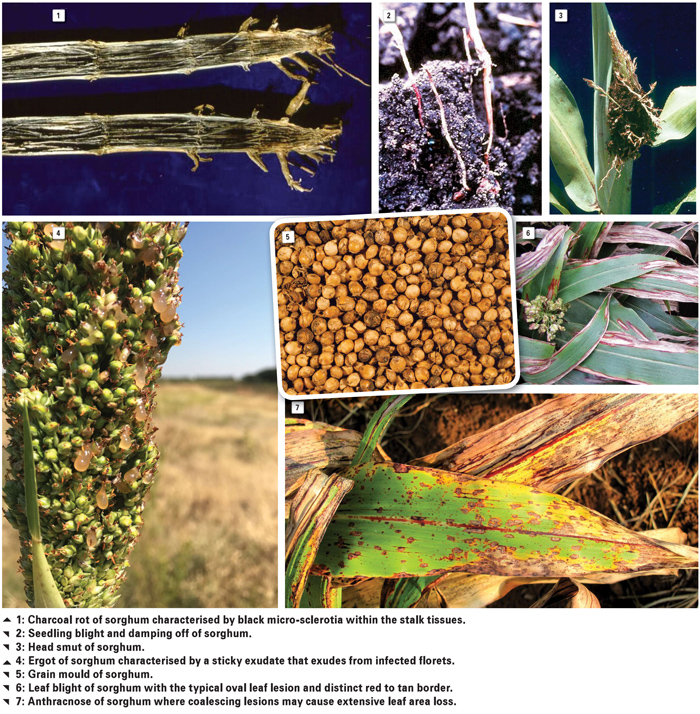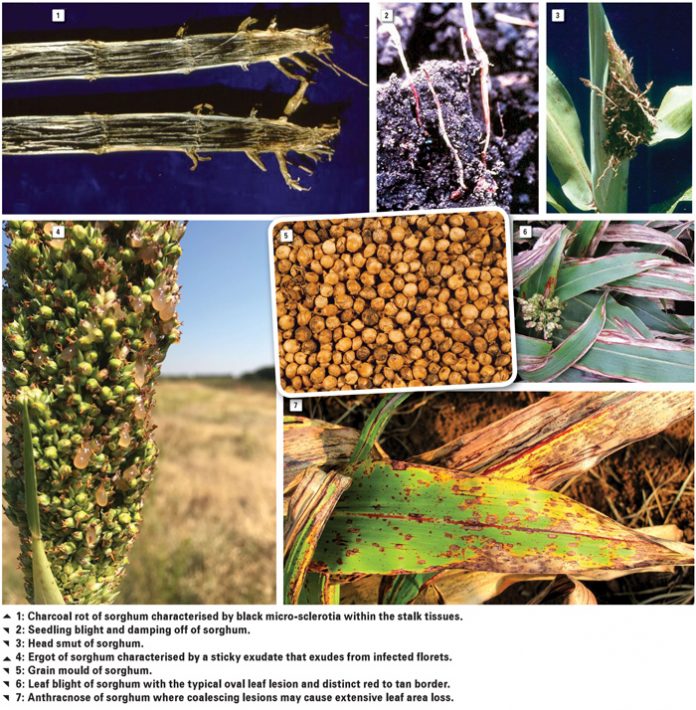February 2019
PROF NEAL MCLAREN and LISA ROTHMANN, Department of Plant Sciences: Plant Pathology Division, University of the Free State
Grain sorghum may be affected by a wide range of diseases. The incidence and severity of these diseases are growth stage and weather dependent. The current fluctuations in rainfall distribution and intensity, as well as increasing temperatures could result in a shift in the importance of diseases over the next few years.
A disease that may fall into this category is charcoal rot (Photo 1) which is defined as a stress-related disease where stress implies low soil moisture and high temperatures. Still, stress can also be defined in terms of low temperature, for example where low soil temperatures associated with early planting dates, predispose seedlings to seedling blights and damping-off (Photo 2).
The later rains experienced over the last few seasons and the later plantings when soils have warmed up sufficiently, may result in this disease complex and diseases such as head smut (Photo 3) which is also dependent on colder soils during the seedling stage, becoming less important.
At the other end of the spectrum are diseases such as ergot (Photo 4), grain moulds (Photo 5) and the risk of associated mycotoxins, which are associated with critical plant growth stages such as flowering, coinciding with late season cooler and wetter conditions due to later plantings. Thus, the changing weather patterns could impact on the incidence of currently important diseases and new threats may also arise.
Disease management
In the pursuit of disease management, reference is often made to ‘resistant cultivars’. Although this is the ideal and cheapest management strategy, the size of the current local sorghum market as well as the need to close the yield gap between sorghum and maize has resulted in disease resistance being secondary to yield and quality.
Cultivars may have varying degrees of disease resistance and many producers pursue yield with the idea of chemical intervention when deemed necessary. Leaf blight (Photo 6) and anthracnose (Photo 7) fall within this category. This too requires careful planning and management in order to be effective and economical.
In Europe for example, only 34% of chemical applications on canola and soybean for the control of Sclerotinia stem rots are deemed necessary or effective. Local sorghum data are not available, but observations suggest this could fall into a similar category.
The Epidemiology sub-division of the Plant Pathology Division of the Department of Plant Sciences at the University of the Free State (UFS) has been focusing on the identification and management of disease driving variables. Much of this research is funded by the Sorghum Trust and aims at providing practical advice to producers which could reduce the risk of disease reaching crop loss thresholds.
A number of advisories are posted below as well as an indication of studies currently being pursued. Producer participation in trials is also being encouraged so as to increase the diversity of weather, soil and agronomic variables under which diseases are studied. Interested parties are encouraged to contact the unit.

Disease management strategies
Disease management strategies are aimed at favouring sorghum growth and development while attacking vulnerable stages in the life cycle of the pathogen so that its development is either prevented or restricted. Internationally it is accepted that there are six general strategies for disease management, five of which are relevant to sorghum. Their application in sorghum production is summarised below.
Exclusion and avoidance as disease control strategies
Exclusion refers to preventing the introduction of a pathogen to a target area while avoidance refers to preventing disease by selecting a time of the year or a site where there is no inoculum or where the environment is not favourable for the initiation of infection. Exclusion in the context of sorghum production would primarily be the use of certified or disease-free seed to prevent the introduction of pathogens into areas where they do not already occur. Exclusion could also include preventing the movement of soil and debris on implements from an infected area to a disease-free area.
Avoidance of sorghum diseases can be construed as misnomers in the strict sense, but practices aimed at reducing the risk of disease favourable environments include the choice of planting date and cultural practices. Sorghum mortality due to a complex of soilborne pathogens during the first three weeks after planting is a recurring challenge in many areas, requiring replanting at considerable seed, fuel and labour cost.
Sorghum seed showing high viability (90%) in standard germination tests often exhibit drastically reduced emergence in the field. Most soilborne fungi are opportunistic pathogens and any condition that reduces seedling vigour can predispose sorghum to infection, thus providing these pathogens the required opportunity.
As alluded to above, a major stress factor is low soil temperature associated with early planting. Prolonged night temperatures of less than 13°C subsequent to planting can reduce seedling growth rates and are particularly favourable for infection. A simple adjustment of planting dates to when soils are warmer can reduce the risk of seedling blights and damping-off. Similarly, low soil pH stresses seedlings and predisposes them to infection by soilborne seedling pathogens.
It is essential to ensure that soil pH does not decrease to pH(H2O) <5,2 if the risk of predisposition is to be avoided. Localised acidification of soil in a band within the seeding zone may occur when band placement of certain fertilisers coincides with cooler, wet weather which in turn predisposes seedlings to infection. Other stresses include excessive planting depths, planting densities and the use of certain pre-emergence herbicides under sub-optimal conditions.
Sphacelotheca reiliana is better known as the causal organism of cob and tassel smut of maize which was very common during the late 1960s and early 1970s. However, the introduction of more susceptible germplasm into the local market has resulted in a significant spread of the disease throughout some production areas in recent years.
On sorghum, symptoms only become evident at flowering. Smut sori replace all or part of the panicle. Initially sori are covered with a white membrane which ruptures to release a mass of black spores. Within the sorus distinct strands of host tissues are preserved which become visible as spores are released.
Other less obvious symptoms of infection by S. reiliana are dwarfing by some cultivars, excess tillering and a weakened root system. Often smutted plants show greater root and stalk rot than unsmutted plants. In some instances, smutted heads only appear on tillers while the primary head remains sterile and produces no grain.
Soilborne spores of S. reiliana germinate and penetrate seedling tissues. After infection the fungus continues to grow systemically and colonises the tissues of the apical meristem. Invaded floral tissues are transformed into the black spore mass at flowering and it is only at this stage that infection is evident. Released spores are re-incorporated into the soil for the next cycle of infection.
Spores can survive for a number of years in a dormant state. Conditions for infection have not been extensively studied. However, slower seedling growth induced by low soil temperatures (<12°C) can promote colonisation of the apical meristem by the pathogen. Thus, as with seedling blights, delaying of planting until soils have had time to warm up and ensure rapid seedling emergence can reduce the risk of infection. Excessive planting depths may also favour head smut.
Avoidance as a strategy also applies to diseases of the inflorescence and grain. Ergot and grain moulds are associated with cool, wet conditions during early flowering and grain development, respectively. Cooler conditions normally occur late in the season, after mid-February, and are normally accompanied by extended dew periods. Planning of flowering dates, either with planting date or cultivar growth period, can reduce the risk of flowering and grain development during these disease-favourable conditions.
Avoidance can also include other risk reduction activities such as population stress often associated with root and stalk rots. Charcoal rot caused by the fungus Macrophomina phaseolina is a major disease where sorghum is produced under hot, dry conditions. The disease generally becomes evident on the maturing crop when plants lodge.
Sclerotia of M. phaseolina become incorporated into the soil with host debris where they can survive for a number of years. Stress reduction can play a major role in reducing the risk of infection. Maintaining soil moisture during grain fill can reduce infection. In higher risk areas, plant populations should be adjusted to reduce the risk of competition and moisture stress.
Eradication as a disease management strategy
Eradication refers to activities that eliminate, destroy, or inactivate inoculum. The disease management strategy of pathogen eradication applies to most sorghum diseases. Soilborne inoculum associated with the seedling disease complex and root rots can be managed with tillage practices and crop rotations.
Both of these practices aim at reducing the nutrient base and thus reduce pathogen growth and proliferation. Conventional ploughing to promote the rapid breakdown of crop debris and prevent the concentration of crop stubble in the upper soil layers is more effective in reducing inoculum than minimum tillage or no-till.
The advantages of the latter as far as factors such as water retention and reduced wind erosion are concerned, should be borne in mind though. Similarly, studies have shown that rotation systems with in particular legumes, can reduce inoculum levels of critical pathogens. Legume rotations have the advantage of stimulating root volume in subsequent sorghum crops which also compensates for root infections, providing for improved water and nutrient uptake and resultant yields.
The strategy of eradication applies to foliar diseases of sorghum. Exserohilum leaf blight caused by the fungus Exserohilum turcicum (syn. Helminthosporium turcicum) and anthracnose caused by the fungus Colletotrichum graminicola are particularly prevalent in warm, wet conditions.
Disease development is favoured by moderate temperatures (18°C – 27°C), heavy dews and high humidity. Dry weather retards disease development. Losses are dependent on the degree of foliar damage prior to flowering. If the disease is well established before panicle emergence, yield losses can be as high as 50%.
If infection is moderate or delayed until after panicle emergence, yield losses are reduced. Foliar disease can occur at any growth stage, although it tends to be more prevalent on mature leaves. The pathogens overwinter as mycelia and conidia in infected leaves, grain and other plant debris. Spores are windborne and can be carried over long distances to host plants.
Secondary infection occurs as a result of spore production within leaf lesions. These spores are spread to new hosts by water and wind. Crop rotation with non-susceptible hosts aids in the destruction of infected crop residues and helps to minimise sources of inoculum for subsequent crops. Similarly, tillage practices aid the breakdown of crop debris.
Biological control by means of organisms such as Trichoderma spp. that suppress pathogen activity or kill pathogens by means of metabolites and direct parasitism, although not widely applied to sorghum, also falls within the strategy of eradication.
Host protection
Host protection refers to the prevention of infection by means of a toxicant or some other barrier to infection. In the sorghum disease context this generally applies to the use of fungicides, although, as above, biological agents may also be included. Particularly in the case of seedling diseases, the use of fungicide seed dressings that reduce the activity of both seedborne and soilborne pathogens and enhance seedling vigour is of paramount importance. Seed dressings can also be specific, for example metalaxyl which can be applied for the prevention of downy mildew (a sporadic disease in South Africa) and carboxin for head smut.
On maize a number of triazole seed dressings have been reported to effectively control smuts, but these are not registered on sorghum. The over-use of metalaxyl in Texas has given rise to fungicide resistant strains of the downy mildew pathogen implying that these chemicals need to be used with caution.
As indicated above, the need to close the yield gap in sorghum has increased the dependence on chemical control of in particular foliar diseases such as leaf blight. Although a number of efficacious fungicides have been identified, only azoxystrobin + difenoconazole and azoxystrobin + epoxiconazole are registered on sorghum for leaf blight control in South Africa while azoxystrobin is registered for anthracnose control.
Studies have indicated that application at eight to ten weeks after planting provide the best level of control. The application of fungicides is not always warranted though, as yield loss depends on host growth stage, weather and leaves infected.
The epidemiology unit at UFS is also working towards a weather-based prediction model that includes plant growth stage and yield loss thresholds, that can be used to minimise the risk of unnecessary application of fungicides providing cost saving as well as reducing environmental contamination.
Trials to date suggest that the yield loss threshold is approximately 15% to 20% leaf area damage although on-going verification is required.
Resistance
Disease resistance remains the most important and economical disease control strategy. But, as indicated above, emphasis on yield and quality more often than not takes preference over resistance. Seed companies regularly screen their releases for disease resistance and advice should be sought regarding the interaction between yield, quality and disease resistance.
The integration of resistance with exclusion, avoidance, eradication and protection strategies could provide significant disease risk reductions that could ensure higher yields and improved grain quality.
For more information contact Lisa Rothmann at 051 401 3666 or coetzeela@ufs.ac.za or Prof Neal McLaren at mclarenn@ufs.ac.za.
Publication: February 2019
Section: On farm level


















